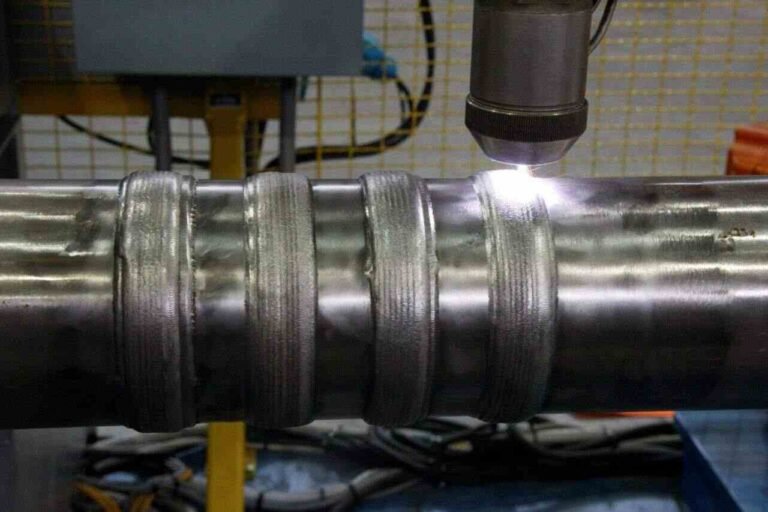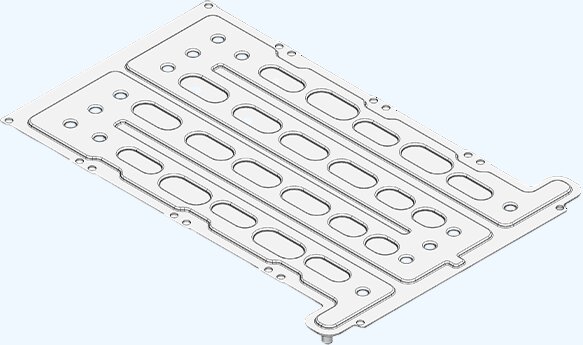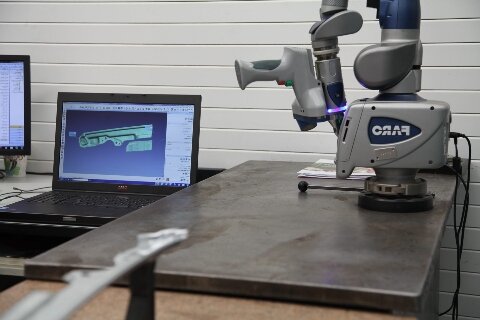Plasmalassen wordt vaak genoemd als we het hebben over geavanceerde lastechnieken. Deze methode is uniek vanwege zijn precisie en efficiëntie bij het verbinden van metalen. Waarom gebruiken we deze methode in toepassingen waar veel vraag naar is? Laten we deze vragen eens onderzoeken.
Het plasmalasproces lijkt op TIG, maar er is een belangrijk verschil: de plasmatoorts. De plasmatoorts creëert een verschroeiend plasma dat metalen nauwkeurig kan smelten. Dit zorgt voor sterkere en schonere lassen, die zeer gewaardeerd worden in industrieën die nauwgezette assemblage vereisen.
Blijf kijken naar de voordelen en toepassingen van plasmalassen in de komende hoofdstukken.
Inzicht in plasmalassen
Wat is plasmalassen?
Een vernauwde boog wordt gebruikt om metaal precies in een klein gebied te smelten. Ioniserende gassen creëren plasma, dat elektriciteit geleidt. Deze vlamboog genereert intense hitte die het werkstuk en eventueel toevoegmetaal kan smelten.
Waarin verschilt plasmalassen van andere lastechnieken?
Plasmalassen is superieur aan traditionele lasmethoden omdat de boog en de warmte-invoer beter te regelen zijn. Het zorgt voor diepere, sterkere lassen en minimale vervorming. Dit verschilt van TIG omdat het met lagere stroomsterktes kan worden gebruikt. Het is ideaal voor fijner werk. Plasmalassen produceert schonere lassen en minder spatten dan MIG-lassen.
De belangrijkste onderdelen van een plasmalassysteem
Ontwerp en functie van de plasmatoorts
De plasmatoorts is expliciet ontworpen om de plasmastraal te richten en te hanteren. Het koperen mondstuk kanaliseert het plasma en richt het op een klein punt op het werkstuk.
Voedings- en regelsystemen
In plasmalassystemen wordt een gelijkstroomvoeding gebruikt om de hitte en stabiliteit van de boog te regelen. Deze regeling is essentieel voor het behoud van de kwaliteit en consistentie van lassen.
Afschermgassen gebruikt bij plasmalassen
Bij plasmalassen zijn beschermgassen essentieel om de lasgebieden te beschermen tegen verontreiniging door de atmosfeer. Gassen zoals helium en argon worden vaak gebruikt. Deze gassen kunnen helpen bij het stabiliseren van het plasma en kunnen laseigenschappen zoals inbranding of lasparelprofielen beïnvloeden.
soorten plasmalassen
Micro plasmalassen
Toepassingen en voordelen
Microplasma-lassen is ontwikkeld voor taken waarbij minimale hitte en maximale lasintegriteit vereist is. Het belangrijkste voordeel is de mogelijkheid om robuust en consistent te lassen bij lage stromen tussen 0,1 en 15 ampère. Dit minimaliseert warmtevervorming en zorgt voor een grotere controle over de lasrupsen.
Geschikt materiaal en diktes
Microplasma-lassen werkt het beste op dunne materialen die meestal tussen 0,1 mm en 3 mm dik zijn. Het is veelzijdig en kan gebruikt worden met vele metalen, waaronder roestvrij staal, nikkellegeringen en titanium.
Sleutelgat Plasmalassen
Wat is het en waarom gebruiken we het?
Als diep penetratielassen zonder toevoegmateriaal nodig is, kan sleutelgatplasmalassen worden gebruikt. Deze methode wordt gebruikt omdat het een volledige penetratielas met hoge snelheid in één doorgang kan maken.
De voordelen van diepe penetratietechnieken
Diepgat plasmalassen heeft verschillende voordelen ten opzichte van andere methoden van diepdiep penetratielassen, zoals laser- of elektronenbundellassen. Het is veelzijdiger qua dikte en materiaalsoort. Het is goedkoper dan laserlassen en vereist geen vacuüm.

Plasmalassen
Het plasmalasproces: Stap voor stap
Bereid je voor en neem veiligheidsmaatregelen.
De operator moet beschermende kleding, handschoenen, helmen en gelaatsschermen dragen. Om giftige dampen te vermijden, moet de werkruimte voldoende geventileerd worden. Het reinigen van de werkstukken maakt ook deel uit van het voorbereidingsproces om verontreinigingen te verwijderen die de kwaliteit van de las kunnen beïnvloeden.
Het plasmalasproces uitgelegd
- Setup: Begin met het aansluiten van gas en stroom op de plasmatoorts.
- Positionering: Plaats je toorts dicht bij het werkstuk.
- De pilotboog starten: Start de vlamboog om het gas te ioniseren en plasma te maken.
- De lasprocedure: Beweeg de toorts met constante snelheid langs de lasnaad voor een goede lasvorming en gelijkmatige warmteverdeling.
- Warmtebehandeling na het lassen: Soms is een nabehandeling na het lassen nodig. Dit hangt af van de toepassing en het materiaal. Dit wordt gedaan om de spanning te verminderen en de mechanische eigenschappen te verbeteren.
Plasmalassen Variabelen
Stroom, spanning en gasstroom
Plasmalassen is voornamelijk een functie van de gasstroom, de spanning en de stroom. De stroom, spanning en gasstroom moeten worden aangepast aan het materiaaltype en de dikte van de las. De warmteafgifte wordt bepaald door de stroom en beïnvloedt zowel de sterkte als de diepte van de las. De spanning beïnvloedt de boogstabiliteit en -lengte, terwijl de gasstroomsnelheid de koeling van de plasmakolom, de bescherming en de stabiliteit van het lasbad beïnvloedt.
Parameters aanpassen aan verschillende materialen
Om de beste resultaten te behalen, zijn voor verschillende materialen verschillende parameters nodig. Om oververhitting te voorkomen, kan het gebruik van lagere stromen met hogere gasstromen nodig zijn wanneer dunne titanium platen lassen. Dikkere roestvaststalen secties kunnen daarentegen hogere stromingen met iets lagere gasstromen nodig hebben om dieper door te dringen.
Toepassingen voor plasmalassen
Industriële toepassingen
- Ruimtevaart en Automobielsector: Wordt gebruikt voor precisielassen van motoronderdelen en structurele elementen.
- Elektronica productie: Ideaal voor de assemblage van kleine en gevoelige elektronische componenten.
Unieke toepassingen van plasmalassen
- Kunst en beeldhouwkunst: Hiermee kunnen kunstenaars gedetailleerde metalen kunstwerken en sculpturen maken.
- Reparatiewerk: Gebruikt om machines en onderdelen in verschillende industrieën te repareren.
Voordelen van plasmalassen
Precisie en controle
- Voordelen van het lassen van dunne platen: Plasmalassen is efficiënt bij het verbinden van dunne platen. Het is ideaal voor precisietoepassingen zoals elektronica en de productie van fijne instrumenten omdat het een hoge nauwkeurigheid en minimale vervorming oplevert.
- Vergelijkingen tussen TIG- en MIG-lassen: Plasmalassen biedt een betere controle over de lasmassa bij lagere stroomsterktes dan TIG-lassen. Dit maakt het ideaal voor delicate taken. Het produceert schonere lassen met minder spatten dan MIG-lassen. Dit verbetert zowel de esthetiek als de structurele sterkte.
Efficiëntie en veelzijdigheid
- Kwaliteit en snelheid van lassen: De geconcentreerde warmtebron maakt plasmalassen sneller dan andere traditionele methoden. Dit resulteert in een sneller lasbad en hogere verplaatsingssnelheden met behoud van hoge kwaliteit.
- Veelzijdigheid van materiaal: Deze methode werkt met verschillende materialen, waaronder roestvrij staal, aluminium, titanium en verschillende legeringen. De veelzijdigheid van deze methode maakt hem geschikt voor een groot aantal industrieën, waaronder de lucht- en ruimtevaart en de auto-industrie.

Uitdagingen en beperkingen
Technische uitdagingen
- Vereisten voor training en vaardigheden: Plasmalassen vereist een hoge mate van vaardigheid. Om de beste resultaten te behalen, moeten operators bekend zijn met de ingewikkelde details van het proces.
- Uitrustingskosten: De apparatuur die voor plasmalassen wordt gebruikt, is duur. Er is ook regelmatig onderhoud nodig om de prestaties en betrouwbaarheid op peil te houden. Dit verhoogt de operationele kosten.
Gebruiksbeperkingen
- Diktebeperkingen: Plasmalassen is praktisch voor materialen met een dunne tot gemiddelde dikte, maar is mogelijk niet geschikt voor dikkere materialen. Het kan moeite hebben om diep door te dringen zonder meerdere laspassen.
- Materiaalbeperkingen: Niet alle materialen zijn geschikt voor plasmalassen. Sommige materialen, zoals kunststoffen of metalen met een hoge reflectiviteit, kunnen moeilijk te lassen zijn met plasma.
Conclusie
Plasmalassen is een nauwkeurige en efficiënte techniek die voor veel industriële toepassingen kan worden gebruikt. Het is ideaal voor dunne materialen, complexe samenstellingen en sectoren zoals lucht- en ruimtevaart en elektronica. De veelzijdigheid en snelheid in het verwerken van diverse materialen maken het een waardevol hulpmiddel voor diverse productieomgevingen.
Heb je een betrouwbare fabrikant van plaatwerkonderdelen nodig? Dan bent u bij Shengen aan het juiste adres. Wij zijn gespecialiseerd in lasersnijden, buigen, oppervlakte-afwerking en CNC-verspaning van plaatmetaal. Neem contact op met Shengen Vandaag nog en zoek hulp bij professionals!
FAQs
Welke materialen kun je lassen met plasmalassen?
Plasmalassen kan worden toegepast op verschillende materialen, waaronder roestvrij staal, aluminiumlegeringen, titanium en nikkel. Het is vooral effectief bij metalen die precieze en hoogwaardige verbindingen vereisen.
Wat is de invloed van plasmalassen op de duurzaamheid en sterkte van een lasnaad?
Door de nauwkeurige warmtebeheersing kan plasmalassen vaak de duurzaamheid van een lasverbinding verhogen. Dit komt omdat het de door warmte beïnvloede zones minimaliseert en thermische vervorming vermindert. Het resultaat zijn sterkere verbindingen van hogere kwaliteit, die essentieel zijn voor toepassingen met hoge prestaties.
Is plasmalassen geschikt voor alle productiegroottes?
Zowel kleinschalige als grootschalige productie kan worden uitgevoerd met plasmalassen. Plasmalassen is ideaal voor toepassingen die gedetailleerd werk vereisen, zoals elektronische assemblages, of grotere projecten, zoals ruimtevaartfabricage.
Meer bronnen:
Micro plasmalassen - Bron: Mig-o-mat
Lassen van sleutelgaten - Bron: Perfectlassen
Hey, ik ben Kevin Lee

De afgelopen 10 jaar heb ik me verdiept in verschillende vormen van plaatbewerking en ik deel hier de coole inzichten die ik heb opgedaan in verschillende werkplaatsen.
Neem contact op

Kevin Lee
Ik heb meer dan tien jaar professionele ervaring in plaatbewerking, gespecialiseerd in lasersnijden, buigen, lassen en oppervlaktebehandelingstechnieken. Als technisch directeur bij Shengen zet ik me in om complexe productie-uitdagingen op te lossen en innovatie en kwaliteit in elk project te stimuleren.




